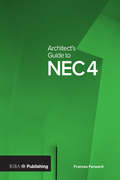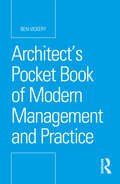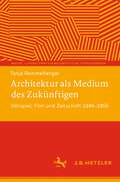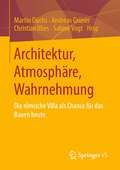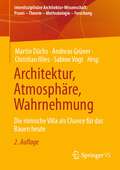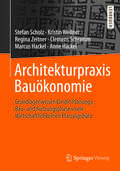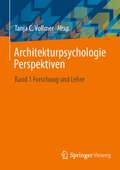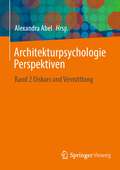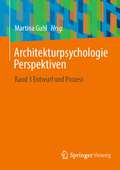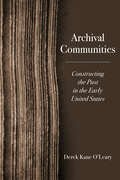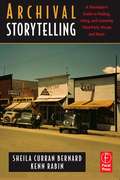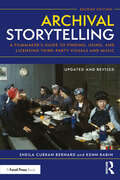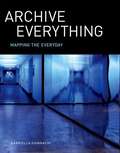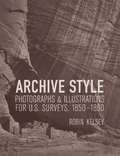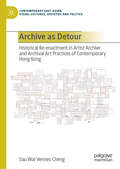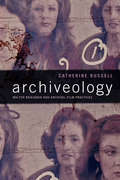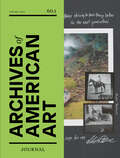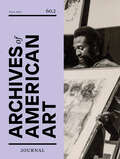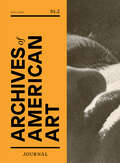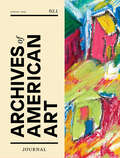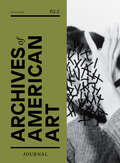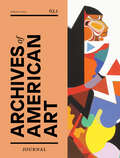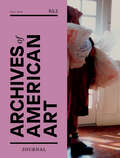- Table View
- List View
Architect’s Guide to NEC4
by Frances ForwardThis user friendly guide introduces, explains, and demystifies the NEC4 contract on a practical, work-based level. Made for architects by an architect, it explores the best approach to collaborative and contractual partnering work practices. Alongside explanations of the contracts and clauses, it presents the key areas of distinction from alternative standard form contracts and examines the integrated project management principles that bring the NEC4 contracts together as a whole. It's the perfect companion book for professionals who are new to the NEC contract family and former users trying to understand the latest updates.
Architect’s Pocket Book of Modern Management and Practice (Routledge Pocket Books)
by Ben VickeryThis book is an easily digestible guide to the management and practice knowledge needed to establish and run an architectural practice. It is of particular interest to those starting out in the profession and to students, whilst also being useful to architects more widely who need succinct information to assist them in the daily management of their work. The book sits beside the Architect’s Legal Pocket Book providing legal information and the Architect’s Pocket Book providing guidance in design. It covers all the main management and practice topics relevant to the running of an architectural business including setting up the company, the profession, project management, fees, office management, financial management and teamwork. It also looks at the state of the construction industry and the architectural profession today, new forms of practice, and how the profession is changing. The book is interweaved with pearls of wisdom and experience and reflections from architects, bringing the topics to life and aiding the reader’s understanding.
Architektur als Medium des Zukünftigen: Hörspiel, Film und Zeitschrift 1945–1955 (Media. Literaturwissenschaftliche Forschungen)
by Tanja RommelfangerDas Buch beschäftigt sich mit der Architektur der unmittelbaren Nachkriegszeit als Gegenstand medialer Repräsentation. Dabei bewegt es sich im Spannungsfeld von Germanistik, Architekturgeschichte und Medienwissenschaft. Anhand von Radiohörspielen, Architekturzeitschriften und Filmen geht es der Frage nach, wie Architektur in Szene gesetzt wird. Dabei bezieht die Analyse mit ein, wie diese im Hinblick auf die Konstruktion und den Aufbau einer neuen Zukunft mit bestehenden Diskursen der Moderne in Verbindung gebracht wird und problematische Bezüge zur nationalsozialistischen Vergangenheit aufweist. In Werken von Günter Eich (Träume, 1951), Otto Renner (BAU. Zeitschrift für wohnen, arbeiten, sich erholen, 1947) und mit einem anonymen Städtefilm (Stein auf Stein. Ein Land baut auf, 1949) werden wenig bekannte Kurzformen aufgegriffen, um deren Verknüpfung mit neuen Medienverbunden und soziopolitischen Diskursen zu erforschen. Die detaillierten Analysen - von Eichs „Fünftem Traum“ als Mediengeflecht von Text, Musik und Geräusch, der heute wenig bekannten, aber zu ihrer Zeit renommierten Architekturzeitschrift BAU als Medienverbund aus zirkulierenden und wiederaufbereiteten Fotografien, Zeichnungen, Texten und Typografie und dem Kurzfilm Stein auf Stein mit seinen intermedialen Bezügen u.a. zur Fotografie - stellen Querverbindungen zu vielen Figuren und Werken dieser Zeit her, in der die Architektur eine Neubewertung als vermittelnde Instanz zwischen Individuum und Gesellschaft erfährt.Davon ausgehend schließt die Autorin auf größere Problematiken, die die Öffentlichkeit in den frühen Nachkriegsjahren beschäftigten. Dabei weist sie Momente des Exzesses und der Überschreitung in den Werken auf, die in einer Zeit der Ressourcenknappheit, Medienregulierung und konfliktreicher Lizensierungspolitik entstanden sind. Auch der Umbruch im Mediengefüge durch die Einführung von Fernsehen und die moralisch aufgeladene Debatte über eine entnazifizierte Öffentlichkeit werden reflektiert. Das Buch geht auch ausführlich auf die Besatzungspolitik im teilautonomen Saarland ein und führt die französische Kolonialpolitik in Algerien indirekt über die Rezeption Le Corbusiers in den deutschen Diskurs ein.Das Buch richtet sich an Studierende und Forschende der Fachgebiete Literatur-, Medien- und Kulturwissenschaft, Kunstgeschichte und Architektur.
Architektur, Atmosphäre, Wahrnehmung: Die römische Villa als Chance für das Bauen heute
by Christian Illies Andreas Grüner Martin Düchs Sabine Vogt„Nach Rom Architekturstudenten zu schicken heißt, sie für ihr ganzes Leben zu ruinieren.“ (Le Corbusier 1922). Im Sinne dieses Verdikts hat sich die Architekturmoderne radikal von der klassizistischen Tradition abgewandt, in der die antike Baukunst als Schulung, Folie und Muster galt, indem man ihre Formen, Strukturen und Proportionen formalästhetisch analysierte und nachahmte. Doch gab es bereits in der Antike ein anderes Konzept von Architekturverständnis: das sinnliche Erleben von Raumsequenzen und die Gestaltung von Atmosphären. Vorgeführt wird uns ein solches Verständnis in Bauten wie der Villa Hadriana aber auch in den „Villenbriefen“ des römischen Senators Plinius d. J. (um 100 n. Chr.). Von Architekten wurden Letztere lebhaft diskutiert, bis die Moderne jede Beschäftigung mit der Antike „untersagte“.Der Band „Architektur, Atmosphäre, Wahrnehmung“ versammelt nun zehn Beiträge, die wieder alle –mehr oder weniger intensiv – als Ausgangsbasis die Villenbriefe nutzen, allerdings nicht, um mit ihnen einen formalästhetischen Zugriff auf die Antike wiederzubeleben, sondern, weil der von Plinius vorgeführte und in der Forschung bis dato vernachlässigte Blick auf die römische Villa unter dem Aspekt einer sequentiellen Sinnlichkeit eine „Chance für das Bauen heute“ ist.Im Ergebnis kann man festhalten: Egal ob man Architekturstudenten nach Rom schickt oder nicht – in jedem Fall sollte man sie Plinius lesen lassen.
Architektur, Atmosphäre, Wahrnehmung: Die römische Villa als Chance für das Bauen heute (Interdisziplinäre Architektur-Wissenschaft: Praxis – Theorie – Methodologie – Forschung)
by Christian Illies Andreas Grüner Martin Düchs Sabine Vogt„Nach Rom Architekturstudenten zu schicken heißt, sie für ihr ganzes Leben zu ruinieren.“ (Le Corbusier 1922). Im Sinne dieses Verdikts hat sich die Architekturmoderne radikal von der klassizistischen Tradition abgewandt, in der die antike Baukunst als Schulung, Folie und Muster galt, indem man ihre Formen, Strukturen und Proportionen formalästhetisch analysierte und nachahmte. Doch gab es bereits in der Antike ein anderes Konzept von Architekturverständnis: das sinnliche Erleben von Raumsequenzen und die Gestaltung von Atmosphären. Vorgeführt wird uns ein solches Verständnis in Bauten wie der Villa Hadriana aber auch in den „Villenbriefen“ des römischen Senators Plinius d. J. (um 100 n. Chr.). Von Architekten wurden Letztere lebhaft diskutiert, bis die Moderne jede Beschäftigung mit der Antike „untersagte“.Der Band „Architektur, Atmosphäre, Wahrnehmung“ versammelt nun zehn Beiträge, die wieder alle –mehr oder weniger intensiv – als Ausgangsbasis die Villenbriefe nutzen, allerdings nicht, um mit ihnen einen formalästhetischen Zugriff auf die Antike wiederzubeleben, sondern, weil der von Plinius vorgeführte und in der Forschung bis dato vernachlässigte Blick auf die römische Villa unter dem Aspekt einer sequentiellen Sinnlichkeit eine „Chance für das Bauen heute“ ist.Im Ergebnis kann man festhalten: Egal ob man Architekturstudenten nach Rom schickt oder nicht – in jedem Fall sollte man sie Plinius lesen lassen.
Architekturpraxis Bauökonomie: Grundlagenwissen für die Planungs-, Bau- und Nutzungsphase sowie Wirtschaftlichkeit im Planungsbüro
by Regina Zeitner Stefan Scholz Kristin Wellner Clemens Schramm Marcus Hackel Anne HackelDiese Lehrbuch stellt das komplexe Tätigkeitsfeld des Architekten aus planungs- und bauökonomischer Sicht dar. Die Aufgaben des Architekten werden prozessorientiert im Sinne eines Qualitätsmanagementsystems vermittelt beginnend bei den Kernprozessen der Planung bis zur Realisierung des Bauvorhabens.
Architekturpsychologie Perspektiven: Band 1 Forschung und Lehre
by Tanja C. VollmerWas können wir aus der Forschung über die Wirkung von Architektur auf Gesundheit und Erleben der Menschen lernen? Wie vermitteln wir die interdisziplinären Erkenntnisse heute und morgen? In diesem Buch wird die Architekturpsychologie als Schlüsselkonzept der gesundheitsbezogenen Evidence Based Design Forschung vorgestellt. Dabei entwickeln renommierte Wissenschaftler:innen aus Deutschland, Dänemark und der Schweiz anhand verständlicher Beispiele ihre Forschungs- und Lehrperspektiven u.a. zum Krankenhaus-, Schul- und Städtebau sowie zum Design. Unterschiede der phänomenologischen, explorativen und empirischen Forschung werden herausgearbeitet sowie hilfreiche Modelle und Konzepte der modernen Architekturpsychologie erklärt. Einleitend wirft der Band einen Blick auf Entstehung und aktuellen Stand der Architekturpsychologie in Deutschland.
Architekturpsychologie Perspektiven: Band 2 Diskurs und Vermittlung
by Alexandra AbelIn der gebauten und vom Menschen beeinflussten Umwelt manifestiert sich unser Leben: Lebenshaltung, Lebensformen, Lebensentwurf. Indem man Architektur neu denkt, hat man daher das Potential, die derzeitige Form unseres Lebens zu überdenken. Ein solches Neu, Anders braucht eine Sensibilisierung für die Relevanz der gebauten Umwelt, für die Werte und Zielgrößen, die hinter einer bestimmten Gestaltung stehen und braucht einen gesamtgesellschaftlichen Diskurs zu der zentralen Frage: Wie wollen wir leben? Wie dürfen wir leben? Vor dem Hintergrund ökologischer und ökonomischer Fairness: Welche Lebensformen sind kompatibel mit einer möglichst hohen Lebensqualität für uns alle, als Teil eines Ökosystems, mit dem unser Wohlbefinden unauflöslich verbunden ist. In diesem Band kommen namhafte Expertinnen aus Österreich, der Schweiz und Deutschland aus den Disziplinen der Architektur, der Psychologie, der Kunst und Kunstdidaktik zu Wort, die sich zu der Relevanz und zu den Voraussetzungen einer solchen Debatte äußern.
Architekturpsychologie Perspektiven: Band 3 Entwurf und Prozess
by Martina GuhlWie findet die Begegnung von Psychologie und Architektur während des Entwurfs- und Planungsprozesses statt? In welchem Planungsabschnitt wird architekturpsychologisches Wissen relevant und einsetzbar? Welche Erkenntnisse liefert die urbane Architekturpsychologie für den städtebaulichen Diskurs? In diesem Buch bringen renommierte Expert*innen aus Deutschland, der Niederlande und der Schweiz aus den Disziplinen Architektur, Psychologie, Städtebau, Farbgestaltung und Kommunikationspsychologie ihr Pionierwissen ein.
Archival Communities: Constructing the Past in the Early United States
by Derek Kane O'LearyThe story behind the creation of the first archives in the new United States Archives, the foundational resource for historical research, do not emerge from a vacuum. The records, documents, and data that make up the historian&’s quarry are never neutral but are themselves the product of historical forces and individual choices. What materials are included in the archive, and why? Whose voices are preserved for posterity, and whose are silenced? In recent years, scholars have increasingly made archives themselves the subject of investigation. With Archival Communities, Derek Kane O&’Leary takes up this crucial task for the era of the early United States, arguing that key components of America&’s archives emerged from within an Atlantic world of circulating scholars, evidence, practices, and ideas. As he shows, US archives—and the historical narratives spawned by the documents preserved within them—drew their initial materials and meaning from this international context. And while demonstrating the disproportionate imprint of powerful men, O&’Leary&’s Atlantic frame reveals a far broader community of people who engaged in early archival efforts on the national, state, and local levels, including women who influenced the act of collection and public perceptions of the young nation&’s historical record.
Archival Storytelling: A Filmmaker's Guide To Finding, Using, And Licensing Third-party Visuals And Music
by Sheila Curran Bernard Kenn RabinArchival Storytelling is an essential, pragmatic guide to one of the most challenging issues facing filmmakers today: the use of images and music that belong to someone else. Where do producers go for affordable stills and footage? How do filmmakers evaluate the historical value of archival materials? What do vérité producers need to know when documenting a world filled with rights-protected images and sounds? How do filmmakers protect their own creative efforts from infringement?Filled with advice and insight from filmmakers, archivists, film researchers, music supervisors, intellectual property experts, insurance executives and others, Archival Storytelling defines key terms-copyright, fair use, public domain, orphan works and more-and challenges filmmakers to become not only archival users but also archival and copyright activists, ensuring their ongoing ability as creators to draw on the cultural materials that surround them.Features conversations with industry leaders including Patricia Aufderheide, Hubert Best, Peter Jaszi, Jan Krawitz, Lawrence Lessig, Stanley Nelson, Rick Prelinger, Geoffrey C. Ward and many others.
Archival Storytelling: A Filmmaker’s Guide to Finding, Using, and Licensing Third-Party Visuals and Music
by Sheila Curran Bernard Kenn RabinFully revised and updated, Archival Storytelling second edition is a timely, pragmatic look at the use of audiovisual materials available to filmmakers and scholars, from the earliest photographs of the 19th century to the work of media makers today. Whether you’re a top Hollywood filmmaker or a first-time documentarian, at some point you are going to want to find, use, and license third-party materials—images, audio, or music that you yourself did not create—to use them in your work. This book explains what’s involved in researching and licensing visuals and music, and exactly what media makers need to know when filming in a world crowded with rights-protected images and sounds. Filled with insights from filmmakers, archivists, and intellectual property experts, this second edition defines key terms such as copyright, fair use, public domain, and orphan works. It guides readers through the complex archival process and challenges them to become not only archival users but also archival and copyright activists. This book is an essential resource for both students and professionals, from seasoned filmmakers to those creating their first projects, offering practical advice for how to effectively and ethically draw on the wealth of cultural materials that surround us.
Archive Everything: Mapping the Everyday
by Gabriella GiannachiIn Archive Everything, Gabriella Giannachi traces the evolution of the archive into the apparatus through which we map the everyday. The archive, traditionally a body of documents or a site for the preservation of documents, changed over the centuries to encompass, often concurrently, a broad but interrelated number of practices not traditionally considered as archival. Archives now consist of not only documents and sites but also artworks, installations, museums, social media platforms, and mediated and mixed reality environments. Giannachi tracks the evolution of these diverse archival practices across the centuries. Archives today offer a multiplicity of viewing platforms to replay the past, capture the present, and map our presence. Giannachi uses archaeological practices to explore all the layers of the archive, analyzing Lynn Hershman Leeson's !Women Art Revolution project, a digital archive of feminist artists. She considers the archive as a memory laboratory, with case studies that include visitors' encounters with archival materials in the Jewish Museum in Berlin. She discusses the importance of participatory archiving, examining the "multimedia roadshow" Digital Diaspora Family Reunion as an example. She explores the use of the archive in works that express the relationship between ourselves and our environment, citing Andy Warhol and Ant Farm, among others. And she looks at the transmission of the archive through the body in performance, bioart, and database artworks, closing with a detailed analysis of Lynn Hershman Leeson's Infinity Engine.
Archive Everything: Mapping the Everyday
by Gabriella GiannachiHow the archive evolved to include new technologies, practices, and media, and how it became the apparatus through which we map the everyday.In Archive Everything, Gabriella Giannachi traces the evolution of the archive into the apparatus through which we map the everyday. The archive, traditionally a body of documents or a site for the preservation of documents, changed over the centuries to encompass, often concurrently, a broad but interrelated number of practices not traditionally considered as archival. Archives now consist of not only documents and sites but also artworks, installations, museums, social media platforms, and mediated and mixed reality environments. Giannachi tracks the evolution of these diverse archival practices across the centuries. Archives today offer a multiplicity of viewing platforms to replay the past, capture the present, and map our presence. Giannachi uses archaeological practices to explore all the layers of the archive, analyzing Lynn Hershman Leeson's !Women Art Revolution project, a digital archive of feminist artists. She considers the archive as a memory laboratory, with case studies that include visitors' encounters with archival materials in the Jewish Museum in Berlin. She discusses the importance of participatory archiving, examining the “multimedia roadshow” Digital Diaspora Family Reunion as an example. She explores the use of the archive in works that express the relationship between ourselves and our environment, citing Andy Warhol and Ant Farm, among others. And she looks at the transmission of the archive through the body in performance, bioart, and database artworks, closing with a detailed analysis of Lynn Hershman Leeson's Infinity Engine.
Archive Style: Photographs and Illustrations for U.S. Surveys, 1850-1890
by Robin KelseyThis imaginative study of American visual culture reveals how the political predicaments of a few small bureaucracies once fostered pictures of an extraordinary style. U.S. geographical and geological surveys of the late nineteenth century produced photographs and drawings of topography, American Indians, geologic features, botanical specimens, and specialists at work in the field. Some of these pictures have long been celebrated for their anticipation of a modernist aesthetic, but Robin Kelsey, in this abundantly illustrated volume, traces their modernistic qualities to archival ingenuity. The technical and promotional needs of surveys, Kelsey argues, fostered the emergence of a taut, graphic pictorial style that imitated the informational clarity of diagrams and maps. As this book demonstrates, these pictures became sites of struggle as well as innovation when three brilliant survey artists and photographers subtly resisted the programs they were hired to serve. Discovering a politics of style behind the modernist look of survey pictures, Kelsey offers a fresh interpretation of canonical western expedition photographs by Timothy H. O'Sullivan and introduces two exceptional but largely forgotten sets of pictures: views of the U.S.-Mexico boundary from the 1850s by Arthur Scott and photographs of the Charleston earthquake of 1886 by C. C. Jones.
Archive as Detour: Historical Re-enactment in Artist Archive and Archival Art Practices of Contemporary Hong Kong (Contemporary East Asian Visual Cultures, Societies and Politics)
by Sau Wai Vennes ChengThe book brings a new approach to see the art history of Hong Kong as a historical mediator and offers alternative perspective to discern the current hype of archive research and archival art practices, which informs the commitment in the constant production of socio-political meanings through arts. The book addresses the current social-political crises of Hong Kong by connecting art, memory, history, and political participation together through the site of archive and contextualises in both local and global perspectives, it also focuses on the artist archive, namely Ha Bik Chuen Archive, and archival art practices of contemporary Hong Kong, particularly in the social and political unrests, however, it ripples resonance and reflection not only in the local context but also to the region. The book is intended to the readers who are interested in both representational and interpretational nature of art and searching for alternatives means to perceive histories.
Archiveology: Walter Benjamin and Archival Film Practices (a Camera Obscura Book)
by Catherine RussellIn Archiveology Catherine Russell uses the work of Walter Benjamin to explore how the practice of archiveology—the reuse, recycling, appropriation, and borrowing of archival sounds and images by filmmakers—provides ways to imagine the past and the future. Noting how the film archive does not function simply as a place where moving images are preserved, Russell examines a range of films alongside Benjamin's conceptions of memory, document, excavation, and historiography. She shows how city films such as Nicole Védrès's Paris 1900 (1947) and Thom Andersen's Los Angeles Plays Itself (2003) reconstruct notions of urban life and uses Christian Marclay's The Clock (2010) to draw parallels between critical cinephilia and Benjamin's theory of the phantasmagoria. Russell also discusses practices of collecting in archiveological film and rereads films by Joseph Cornell and Rania Stephan to explore an archival practice that dislocates and relocates the female image in film. In so doing, she not only shows how Benjamin's work is as relevant to film theory as ever; she shows how archiveology can awaken artists and audiences to critical forms of history and memory.
Archives of American Art Journal, volume 60 number 1 (Spring 2021)
by Archives of American Art JournalThis is volume 60 issue 1 of Archives of American Art Journal. First published in 1960 as the Archives of American Art Bulletin, the Archives of American Art Journal is the longest-running scholarly periodical devoted to the history of art in the United States. This peer-reviewed publication showcases new approaches to and out-of-the-box thinking about primary sources. All contributions must be appropriate for the journal's broad audience and engage in a substantial, meaningful way with the holdings of the Archives of American Art.
Archives of American Art Journal, volume 60 number 2 (Fall 2021)
by Archives of American Art JournalThis is volume 60 issue 2 of Archives of American Art Journal. First published in 1960 as the Archives of American Art Bulletin, the Archives of American Art Journal is the longest-running scholarly periodical devoted to the history of art in the United States. This peer-reviewed publication showcases new approaches to and out-of-the-box thinking about primary sources. All contributions must be appropriate for the journal's broad audience and engage in a substantial, meaningful way with the holdings of the Archives of American Art.
Archives of American Art Journal, volume 61 number 1 (Spring 2022)
by Archives of American Art JournalThis is volume 61 issue 1 of Archives of American Art Journal. First published in 1960 as the Archives of American Art Bulletin, the Archives of American Art Journal is the longest-running scholarly periodical devoted to the history of art in the United States. This peer-reviewed publication showcases new approaches to and out-of-the-box thinking about primary sources. All contributions must be appropriate for the journal's broad audience and engage in a substantial, meaningful way with the holdings of the Archives of American Art.
Archives of American Art Journal, volume 61 number 2 (Fall 2022)
by Archives of American Art JournalThis is volume 61 issue 2 of Archives of American Art Journal. First published in 1960 as the Archives of American Art Bulletin, the Archives of American Art Journal is the longest-running scholarly periodical devoted to the history of art in the United States. This peer-reviewed publication showcases new approaches to and out-of-the-box thinking about primary sources. All contributions must be appropriate for the journal's broad audience and engage in a substantial, meaningful way with the holdings of the Archives of American Art.
Archives of American Art Journal, volume 62 number 1 (Spring 2023)
by Archives of American Art JournalThis is volume 62 issue 1 of Archives of American Art Journal. First published in 1960 as the Archives of American Art Bulletin, the Archives of American Art Journal is the longest-running scholarly periodical devoted to the history of art in the United States. This peer-reviewed publication showcases new approaches to and out-of-the-box thinking about primary sources. All contributions must be appropriate for the journal's broad audience and engage in a substantial, meaningful way with the holdings of the Archives of American Art.
Archives of American Art Journal, volume 62 number 2 (Fall 2023)
by Archives of American Art JournalThis is volume 62 issue 2 of Archives of American Art Journal. First published in 1960 as the Archives of American Art Bulletin, the Archives of American Art Journal is the longest-running scholarly periodical devoted to the history of art in the United States. This peer-reviewed publication showcases new approaches to and out-of-the-box thinking about primary sources. All contributions must be appropriate for the journal's broad audience and engage in a substantial, meaningful way with the holdings of the Archives of American Art.
Archives of American Art Journal, volume 63 number 1 (Spring 2024)
by Archives of American Art JournalThis is volume 63 issue 1 of Archives of American Art Journal. First published in 1960 as the Archives of American Art Bulletin, the Archives of American Art Journal is the longest-running scholarly periodical devoted to the history of art in the United States. This peer-reviewed publication showcases new approaches to and out-of-the-box thinking about primary sources. All contributions must be appropriate for the journal's broad audience and engage in a substantial, meaningful way with the holdings of the Archives of American Art.
Archives of American Art Journal, volume 63 number 2 (Fall 2024)
by Archives of American Art JournalThis is volume 63 issue 2 of Archives of American Art Journal. First published in 1960 as the Archives of American Art Bulletin, the Archives of American Art Journal is the longest-running scholarly periodical devoted to the history of art in the United States. This peer-reviewed publication showcases new approaches to and out-of-the-box thinking about primary sources. All contributions must be appropriate for the journal's broad audience and engage in a substantial, meaningful way with the holdings of the Archives of American Art.
